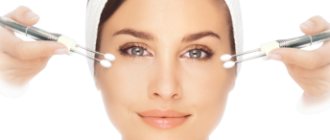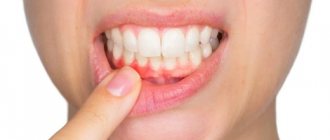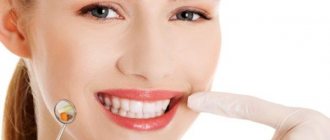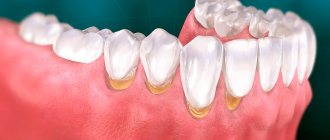Healthy gums are the key to strong teeth and a beautiful smile. Normally, they are pink, cover the alveolar processes and necks of dental units, and are not damaged. Based on their condition, the dentist can judge the health of the oral cavity.
Soft tissues are the first to react to negative changes occurring in the body. Redness of the gums is one of the main signs of inflammation. It can be associated with various factors - from drinking too hot drinks to the development of periodontitis. Find out if it is dangerous and in what cases you need medical help.
Causes of the inflammatory process
Why are my gums red? Among the causes of the defect are:
- weakening of the immune system;
- allergic reactions to food irritants or dental care products;
- gum injury;
- inflammatory processes in internal organs;
- taking strong medications;
- avitaminosis;
- insufficient or illiterate oral care.
Pathogenic flora can affect not only the upper part of the gums, but also its deep tissues. Due to these disorders, pockets filled with pathogenic flora and food particles are formed between the bone tissue and soft structures. In advanced cases, patients experience not only redness of the gums, but also unsteadiness of the elements of the row. Symptoms indicate irreversible processes in the tooth and gum tissue that cannot be treated with medication. Inflammation and redness of the gums can be successfully treated only in the early stages of development.
In an adult, the defect is associated with dental diseases or age-related changes in the body. In the latter case, the gums slowly dry out in height due to impaired functioning of the blood vessels. Soft and hard tissues are deprived of oxygen in the required quantity, which causes tooth loss.
The problem often occurs in adult patients suffering from pathologies of the liver, gall bladder and tuberculosis.
Minor microdamages and scratches can lead to inflammatory processes in the mouth. Pathogenic flora gets into microcracks, where it actively multiplies
If the gums are red, this may indicate a lack of vitamin C in the body. Without timely treatment, the disease leads to complete edentia.
The risk of developing inflammation of the soft tissues of the mouth exists in people who select brushes with hard bristles or toothpastes with an aggressive chemical composition. Gingivitis and periodontitis are diagnosed in women who have been taking oral contraceptives or medications for high blood pressure for a long time.
Inflammatory processes in the mouth are more often diagnosed in people who smoke. Nicotine, which is part of cigarettes, helps to weaken the immune system and dry out the mucous membranes of the mouth, due to which pathogenic agents multiply faster.
Women suffer from gum inflammation during pregnancy, as at this time their body undergoes serious hormonal changes. In pregnant women, redness of the oral tissues is accompanied by swelling and bleeding.
Red gums in a child are observed with leukemia. This is due to the fact that atypical cells primarily affect the soft tissues of the mouth.
The problem is observed in those children whose parents suffered from dental diseases, since in most cases the pathology is hereditary. In babies under 1 year of age, redness develops due to the habit of pulling foreign objects or hands into the mouth. Inflammation of the gums occurs despite the high antiseptic properties of saliva in infancy.
Another cause of pathology in young children is teething and accidental injury to the mucous membranes due to careless food consumption. In school-age children, periodontitis occurs due to untimely treatment of primary carious teeth.
The opinion that baby teeth do not require therapy is a common mistake among parents. Adults should not only help their child take care of their teeth, but also take them to the dentist regularly. Failure to comply with these rules leads to inflammation of the baby’s gums and subsequent complications that affect the child’s bite in adulthood.
Causes of gum swelling
Physiological
Normal gums are pink, painless and of normal size. But sometimes they swell for natural reasons:
- during teething - in children and adults (wisdom teeth);
- after tooth extraction—slight swelling and redness of the gums is observed for up to 3 days;
- after injury - damage to the soft tissues of the gums leads to their swelling for some time while integrity is restored;
- during pregnancy - under the influence of hormones and due to the redistribution of blood in the body, gums may swell in women carrying a child;
- injury from dental structures - veneers, braces and fillings, if installed incorrectly, come into contact with gum tissue, causing damage to them.
There is no need to panic if the gums of a child aged 1 to 7 years are swollen. At this time, baby or permanent teeth erupt, which may cause swelling and redness in this area. Sometimes small balls appear - cysts. They are safe and in most cases go away on their own over time. If the cyst interferes with tooth eruption, it is surgically removed in dentistry in 1 session. The procedure is performed under anesthesia and does not cause any discomfort.
Pathological
In most cases, gum swelling occurs due to inflammation. Pathological reasons:
- periodontitis - local inflammation above or below the tooth;
- periodontitis - inflammation of periodontal tissues;
- gingivitis - inflammation of the gums;
- periodontal abscess - suppuration localized at the edge of the tooth;
- stomatitis - ulcers that appear on the soft tissues of the oral cavity;
- secondary infection against the background of immunodeficiency - with HIV or hepatitis, even opportunistic microorganisms can cause oral diseases;
- atypical sore throat - spreads to the gums, the main symptom is that it is painful for a person to swallow;
- Vitamin deficiency C - a lack of vitamin affects the gum tissues, causing them to swell.
Swelling of the gums due to an allergic reaction is also considered pathological. It can develop from an injection of an analgesic during dental treatment or from any irritant to which a person is sensitive.
Symptoms of the problem
You should consider the main diseases that cause redness of the gums and their distinctive signs:
Causes of gum inflammation
- Gingivitis. The disease is associated with damage to the tissue near the tooth by harmful agents. The main cause of the problem is improper oral care. Untreated gingivitis is complicated by periodontitis or periodontal disease, and tooth loss. The main signs are pain when eating and brushing teeth, bad breath, and fever.
- Periodontitis. In pathology, the soft tissues around the tooth are affected. The disease is acute with pronounced symptoms, as well as changes in pain intensity. The pathological process develops within 7-14 days. If not treated in a timely manner, periodontitis can lead to heart attack, stroke, loss of dentition, and intoxication of the body.
- Periodontal disease. During the disease, the tissues surrounding the teeth also become inflamed. A distinctive feature of the pathology is sluggish development. The problem occurs with hidden symptoms for several years, but ultimately leads to the loss of units. The main signs of periodontal disease: unsteadiness of elements, red growths on the gums, divergence of teeth in different directions. Untimely treatment of periodontal disease can lead to diseases of the gastrointestinal tract due to inadequate chewing of food.
Swelling of the gums with acute pain
When the gums are not only swollen, but also very painful, this may be a symptom of a serious pathology of the oral cavity. Most often, such complaints are accompanied by periodontitis. This is an inflammation of the soft tissues that support the tooth. Other symptoms of periodontitis include:
- increased body temperature;
- suppuration in the area of swelling;
- lack of temperature sensitivity of the tooth, as well as a reaction to sweets.
If swelling in the gums is accompanied by fever, it may be periodontitis. This is due to the fact that the factors in the development of pathology are most often related to infection.
Causes of periodontitis:
- transition of the inflammatory process from the throat or sinuses to the gums;
- penetration of microbes through the dental canal into the periodontium;
- advanced caries;
- poor-quality dental treatment, due to which irritating substances entered the periodontium;
- trauma to the periodontium or the tooth located next to it.
In rare cases, periodontitis develops as a consequence of an immunological reaction, that is, an allergy.
Emergency help for inflammation
What to do if your gums hurt? First aid to relieve symptoms is provided at home. It is recommended to regularly (once every 2 hours) rinse your mouth with antiseptic solutions - furatsilin, baking soda, chlorhexidine.
To treat redness of the gums, ointments with an antiseptic and hemostatic effect are used.
The basic rule of emergency care is the exclusion of radical methods of treatment: such therapy leads to serious consequences. To stop the proliferation of pathogenic flora, herbal tinctures sold in pharmacies without a prescription are suitable - Givalex, Stomatodin, Mevalex. The products are used according to the instructions for use.
Treatment options
You won’t be able to deal with the problem on your own using emergency methods alone. To prevent dangerous complications, a person will need to consult a qualified doctor. Before drawing up a treatment plan, the dentist will examine the oral cavity and, if necessary, recommend instrumental examinations - x-rays, panoramic photographs. Severe cases of the disease require an integrated approach - antibiotic therapy, the use of products for local treatment of inflamed areas and traditional medicine recipes.
Medicines for local treatment of the mouth
What to do if there is inflammation of the soft tissues of the mouth? The pharmacological industry offers a wide range of products to combat the problem, which are available in the form of sprays, ointments, gels and applications. All drugs are supplied with instructions for use. The specialist can adjust the frequency of use of the medicine, which is indicated in the instructions, depending on the severity of the problem and the form of its course.
If the gums are swollen and accompanied by bleeding, then antiseptic rinses are recommended for therapeutic purposes:
- Listerine. Use 2 times a day for 30 seconds. The course of treatment is 5-10 days.
- Stomatophyte. Use up to 4 times a day for up to 15 days.
- Furacilin - up to 3 times a day.
- Chlorhexidine. For periodontitis in adults, a solution at a concentration of 0.2% is prescribed; in children, swollen gums are treated with a 0.05% solution. Rinse your mouth after eating until the unpleasant symptoms disappear completely.
- Chlorophyllipt. Effectively acts against streptococcal infections. Before use, the solution is diluted with boiled water in a ratio of 1 tbsp. l. medications per 200 ml of liquid.
The effect of rinses is enhanced by simultaneous applications of healing ointments and gels.
The purpose of the applications is to apply medicinal agents to the gums under the film. The drugs create a protective layer on reddened areas and contribute to the death of pathogenic flora
Among the effective means for applications are:
- Periodontocyte, consisting of mint, oregano and sage;
- Gengigel with hyaluronic acid, due to which enhanced regeneration of lesions occurs;
- Stomatofit for pain relief of inflamed gums;
- Cholisal for the treatment of periodontitis in children and adults;
- Solcoseryl for pain relief in damaged areas and their speedy healing.
You can treat gum inflammation with special toothpastes. They are also used for preventive purposes. These drugs contain anti-inflammatory herbs and antimicrobial components. Among the best pastes, we should highlight: Lakalut, Mexidol phyto; The president. It is recommended to use these products for brushing your teeth for no more than 1 month.
Antimicrobial agents are used in rare cases, for example, when signs of intoxication of the body appear. Antibiotics not only suppress the signs of periodontitis, but also help restore the functions of all systems. Taking medications from this group is possible only with the permission of the dentist. The doctor selects the appropriate remedy and determines its dosage.
Traditional medicine recipes are used as additional drugs to medications in the treatment of gum inflammation
Natural remedies are allowed for both adults and children. For the latter category of patients, one-component recipes and products that do not contain bee products are selected.
Red gums are treated with the following recipes:
- Concentrated soda solution: 1 tsp. The product is dissolved in 200 ml of water. The mixture is used every 2 hours to treat red spots.
- Linden blossom: 1 tbsp. l. linden flowers are poured with 250 ml of cold water and left for 5 hours. The medicine is used every 4 hours to rinse the mouth.
- Fir oil. Used if there are bumps or bleeding wounds on the surface of the inflamed gum. A gauze swab dipped in oil is applied to problem areas for 15 minutes 2 times a day.
- Linden honey and a rusty nail. The recipe is used to remove boils and purulent abscesses. To do this, the nail is heated until red and placed in honey. A black substance forms around the nail and is used to lubricate the gums.
Principles of treating gum disease
The treatment regimen is developed by the doctor depending on the type of pathology that is accompanied by redness of the gums. Each dental disease requires an individual approach.
Gingivitis
The problem is characterized by inflammation of the periodontal papillae and the appearance of small pimples in this area. Treatment of the problem begins with the removal of hard and soft deposits from the surface of the enamel. After this, local anti-inflammatory and decongestant drugs are prescribed. The prognosis for recovery from gingivitis is usually favorable.
Periodontitis
The disease is considered a more serious form of gum tissue damage. If left untreated, the periodontal papillae atrophy, and balls filled with pus form in the periodontal pockets. Treatment of the disease is carried out in stages: taking or injecting antibiotics into the gums; splinting of moving elements of a row; surgical formation of atrophied areas of the gums.
Inflammation of the gums requires immediate treatment, since if the pathological process is complicated, periodontal disease or complete loss of the dentition may develop. There are many ways to combat the problem at home. Therapy includes the use of pharmacological drugs and traditional medicine. Mild forms of inflammation can easily be eliminated in a few weeks if all the rules outlined by the dentist are followed.
Removal of epulis on the gum
The need to remove the supragingival tissue occurs when the tumor is large, is growing rapidly, or is at risk of cancer. The procedure is complex and can only be performed by an experienced oral or maxillofacial surgeon.
Removal of epulis on the gum takes place under local anesthesia or sedation. The essence of the operation is to remove the lump and excise the affected tissue. Excision of the epulis itself can be done with a scalpel or laser. Dentists prefer a laser that can instantly stop bleeding and make precise “cuts.”
If the pathological process has penetrated deeply, it is possible to remove a section of bone using a cutter or bur. If teeth are damaged in the area where the tumor is located (loose teeth, exposed roots, etc.), the surgeon removes these teeth as well.
After the operation, the patient is covered with iodomorphic gauze. If there is a large area of dissection, the surgeon will apply sutures. A sterile bandage is applied over it.
In case of angiomatous and fibromatous appearance, removal of epulis on the gum can also be carried out if conservative therapy has not yielded results or the patient seeks help in the presence of complications.











